Dear Reader, in this age of AI created content, please support with your goodwill someone who works harder to provide the human-made. Sign up at the top of the lefthand column or bottom of this page. You will receive my hand illustrated monthly newsletter RESTORE NATURE and access to the biodiversity garden design course as I write...and nothing else, I respect your time. I am also removing the advertizing as best I can as its become intrusive inappropriate and pays me nothing.
edible wild berries
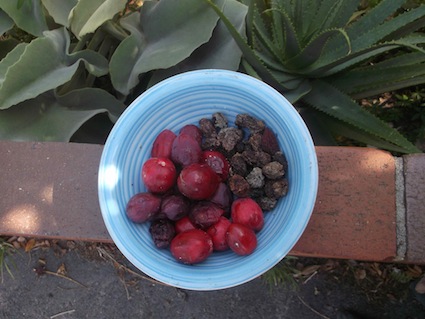
Edible wild berries and seeds which grow in this region could enrich our diet and for those with commercial potential provide hardy crops which require less water than Eurasian and Tropical fruits.
I've also written on the many wild fruits of the family Solanaceae, found in the Americas, Africa and Australia, and I'm building a garden pond system in which I hope to grow cranberries.
In any country, berries growing in the wild may have the highest concentrations of phytochemicals, like anti-oxidants, and second to that, these same wild berries grown in a garden setting organically. The reason is in their culture. It is well known that a little stress produces higher phenolic content in grapes and therefore better wine, and it is suspected that the subsoil conditions, such as massive boulder fields, may play a part in creating the right amount of stress. A berry plant growing wild undergoes whatever conditions are imposed by nature, whereas a cultured plant is watered and fed fertilizers. In culture, in the garden, one needs to get the balance just right. Overwatering or overfeeding may reduce flavor and phytochemical content. Provide conditions in which the plant survives without being pampered. As you can imagine, native berries are more likely to survive neglect, while tender exotic berries will not do well. In every region of the world there will be wonderful nartive berry plants which you can use.
Those berries which need more water than your climate supplies, and need to be pampered, may be able to grow in a grey water biofilter. If you would like to build one for growing water hungry plants, I have written a book on the subject which will be on special from the 10th to 17th of September 2019, for $1.99. See the right hand bar at the top.
South African berries hold up very well in comparison with the globally proclaimed 'super foods'. We really don't need to all rush to the store and buy blueberries as if the exotic was more powerful than our own. Our berries are some of the most potent anti-oxidant foods in the world (see link at page bottom). This research article shows the anti-oxidant potency of local berries, and I cite them here from the top down, according to their rating on the anti-oxidant potency composite index: wild plum (225), colpoon (174), wild olive (173), then the trendy western blueberry (146). Following are the christmas berry (106), cross berry (74), waterberry (44) till we finally get to another trendy exotic the cranberry with 38 ! Below that is the tortiose berry (37), bietou (32), num num (27) and humble sour fig (21).
Earlier on the 17th of May I had the privilege to attend a fascinating
talk by Loubie Rusch. She is a landscape designer turned activist for
indigenous foods, who has experimented extensively with the use of our
wild berries and seeds in creative new ways, (bravely, I might add) and
has helped establish a number of wild food gardens on the Cape Flats.
She can be found on the facebook page Making KOS. I took copious notes
at her lecture on the species she’s used and some of her tried and
tested ideas ideas on how they can be used as ingredients in innovative
ways. There was so much information, I could not keep up with my note
taking, but this here is some of it, to give one a taste of the creative
possibilities in the use of indigenous wild berries and seeds as food.
What to do with wild berries and seeds
Loubie made a joke about her default culinary experiment trying all these wild berries in gin ! They often give the gin interesting beautiful colours, like intense pinks.
She started with Sideroxylon inerme (milkwood). The latex from the berries is very sticky and gummy and has to be scrubbed off containers. She’s tried them in gin, cordials and for flavoring vinegar.
Euclea Racemosa (Guarrie) has been likewise experimented with, as has Osyris compressa (pruimbas).
Lycium ferocissimum (slangbessie, relative of yogi berry) has a very fine flavour, sweet savory and tomato like. It is a very thorny shrub.
Asparagus sp. Have berries but the seeds are very bitter generally.
Dipogon lignosis creeper has pea like young fruits. They are available at Goodhope Nursery.
Carissa macrocarpa or bispinosa (Num Num, also known as Amatungulu) fruit can be found all around the city in public plantings as hedge plants. These large wild berries, the size of small plums, bear on the 2nd year growth and the city often trim them too frequently for them to bear. They are available at nurseries. I have heavy bearing bush which is seldom pruned in Goodwood. On my plant at at home, I’ve found that many fruit which dry on the bush have lost their physical integrity, and powder to dust, and a small fraction of the fruit have dried up with colour and integrity. Pick these good dried fruit. The low hanging fruit are regularly harvested by other people, and I’ve even had a lady knocking on my door and asking if she could come into the garden to harvest. She explained she was from KZN and missed eating these berries a lot. I find them incredibly delicious fresh and ripe with vanilla ice-cream, but I’m lazy, much more can be done with them. The dried on the bush wild berries and can be harvested to use in baking, mustard, jams, brownies, and baked with pears. Loubie has made jams from the fresh and the dried form.
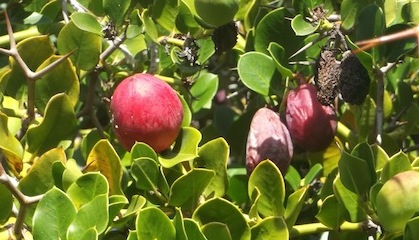 Harvest these wid berries originating in Kwazulu-Natal with braai tongs to avoid thorns
Harvest these wid berries originating in Kwazulu-Natal with braai tongs to avoid thornsCarissa bispinosa, Num Num or Amatungulu
Dovyalis caffrum (Kei Apple) is also available at nurseries. I find the flavour not reminiscent of an apple at all, but of a beautifully perfumed apricot. Loubie recommends harvesting fallen fruit because the bush is hellishly thorny. They have male and female trees, and indeed, I only have 2 in Goodwood and they have never borne fruit, though 20 years old, and now I know why ! Make sure you have both sexes when you buy from a nursery.
Searsia crenata (crowberries or kraaibessies) and the many other Searsia species, have been refered to as a superfoods, presumably because of their nutritional content, which is yet to be tested. When green they are intensely sour, whin ripe they are juniper like. They are available at some nurseries.
Searsia laevigata, S lucida and S glauca also have berries. Use them green in stir fries with sandkool (see page on green carpet edibles). Dry roast the green berries and combine with seeds in yoghurt sauces for fish. S glauca ground with castor sugar and bullrush pollen can be used in baking. The plants are available at nurseries.
Osteospermum monoliferum (bietou) the berries and flowers have a caramel flavour when ripe. You can add them to cider vinegar or snack on them straight off the bush. Available at nurseries.
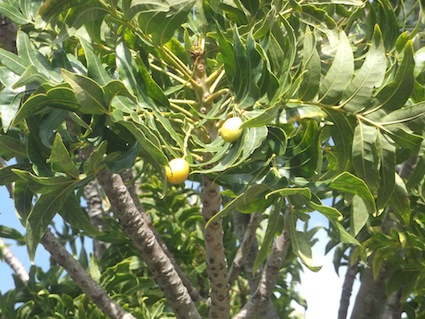 The wild berries of Harpephyllum when green
The wild berries of Harpephyllum when greenHarpephyllum caffrum berries grow on a large tree often found as a street tree in South Africa. The berries are very high in pectin, so they can be mixed with low pectin berries like strawberries to set jam. They are also very high in anti oxidants, the same wild plum, mentioned above.
Loubie uses them in a cordial with Num Nums. I loved these berries as a child in Port Elizabeth. We spent lots of time climbing the tree or gathering them off the ground. They are available in nurseries and I grow them from seed for sale. Those which grow as street trees in Goodwood are never harvested, it appears. (Loubie notes – most aren’t). I have harvested them and used them for making tiny quantities of wine to make vinegar. The wine and vinegar had a superb aroma and aged well.
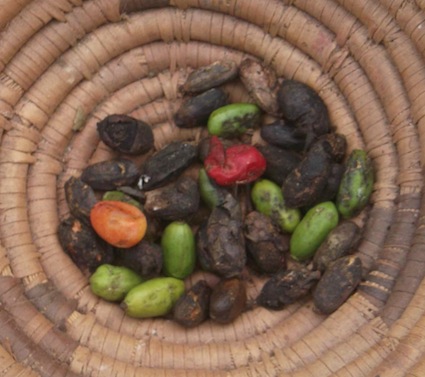 Foraging today from street trees. Harpephyllum fruit in various stages of ripeness and desiccation
Foraging today from street trees. Harpephyllum fruit in various stages of ripeness and desiccation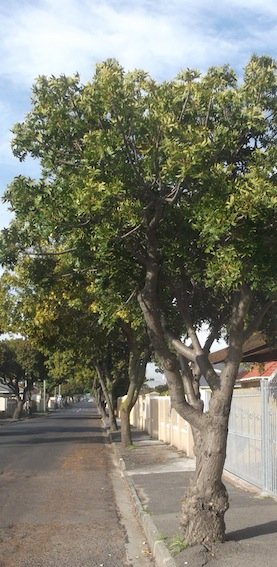 The hardy Harpephyllum caffrum is often used as a street tree.
The hardy Harpephyllum caffrum is often used as a street tree.Syzigium cordatum (waterberry) produce black berries on big trees which are also commercially available at nurseries. It is often grown in parking lots or as a street tree.
Acacia karoo (soetdoring or sweet-thorn) has pods which when young have delicious seeds. They can be used as a coffee substitute when ripe and dry, or can be eaten raw ground in yoghurt, or added like a spice to salt. For sale in nurseries. I tasted these minute, fresh and pale peas recently on my tree at home. They are somewhat mealy in flavour, and slightly sweet, with a delicate wild legume flavor. We also used to collect the gum of the tree and other thorn trees, and eat it as children. Perhaps this could be used as a sugar replacement in small quantities.
Foraging in this region for wild berries is a very ancient practice
The diverse flora of the Cape and the southern regions of Africa was used for millennia by Khoesan people living in this region, who made use of over 500 plants species before the arrival of the colonists. The rich indigenous plant lore has remained with some individuals, passed by word of mouth from generation to generation. In the Fynbos region, general knowledge of the uses of a very much smaller number of plants has survived. Some words in the Afrikaans language, like soutslaai or “salt lettuce” also remain. In my personal experience the use of indigenous plants can be eloquently seen in the lexicon of Khoekhoegowab, which I studied for my Master’s degree in Linguistics. Not only the names of plants and animals, but the verbs for processes, show that these plants were used in very diverse ways: soaked, bleached, leached and blanched, squeezed for sap, drained, burned, roasted, pounded, chopped, mashed, ground, milled, fermented, dried and more.
The vocabulary for culinary processes in Khoekhoegowab appears to be
much larger than the original Anglo Saxon vocabulary in English. The lexical development mechanism in Khoekhoegowab leaned more on the creation of terms, whereas in English we borrow. English has borrowed most cooking terms from French “cuisine” (and
there you have an example) in the late Middle Ages. Whereas Khoekhoegowab has thousand of richly descriptive terms that normally would require a whole phrase in English.
I hope this has inspired you to help with the reintroduction of these wild foods into our diet, and to promote their growth and propagation in wild reserves, in all indigneous planting projects, in guerilla gardens, horticultural projects and farms.
------
home page for inspiration on eco wise gardening and saving resources
------
the garden, green methods, permaculture
------
Many South African berries have potent anti-oxidant properties
------
------
food from Nature in the Cape Floral Kingdom
------
African food varieties of the Cape region
------
vegetable gardening the natural low cost way
------
Loubie Rusch's facebook page Making KOS
You’re a home gardener ! Share your experiences and questions !
We all know about home gardening. Tell us about your successes, challenges and ask about issues that bother you. You may have the luxury of a back garden, but there are other ways we learn. Few people age without growing something or buying vegetables during their lives ! It is absolutely guaranteed that you have learned things which can help others on their gardening journey.
We invite you to share your stories, ask questions, because if a thing has bothered you it will bother others too. Someone may have a solution ! No question is too small. There is learning for everyone involved, for you, for me (yes, I learn from every question), for us all. Exciting stuff !
We are starting on a new journey. Every week we will profile your letters ! The best stories and questions we receive.
What Other Visitors Have Said
Click below to see contributions from other visitors to this page...
thorns, birds, wild berries and ecologies Not rated yet
Carissa bispinosa, a delicious South African fruit, like a plum but very tart with milky sap, bears horrific thorns. I never expected my bushes to grow …
Restore Nature Newsletter
I've been writing for four years now and I would love to hear from you
Please let me know if you have any questions, comments or stories to share on gardening, permaculture, regenerative agriculture, food forests, natural gardening, do nothing gardening, observations about pests and diseases, foraging, dealing with and using weeds constructively, composting and going offgrid.
SEARCH
Order the Kindle E-book for the SPECIAL PRICE of only
Prices valid till 30.09.2023
Recent Articles
-
garden for life is a blog about saving the earth one garden at a time
Apr 18, 25 01:18 PM
The garden for life blog has short articles on gardening for biodiversity with native plants and regenerating soil for climate amelioration and nutritious food -
Cape Flats Sand Fynbos, Cape Town's most endangered native vegetation!
Apr 18, 25 10:36 AM
Cape Flats Sand Fynbos, a vegetation type found in the super diverse Cape Fynbos region is threatened by Cape Town's urban development and invasive alien plants -
Geography Research Task
Jan 31, 25 11:37 PM
To whom it may concern My name is Tanyaradzwa Madziwa and I am a matric student at Springfield Convent School. As part of our geography syllabus for this
"How to start a profitable worm business on a shoestring budget
Order a printed copy from "Amazon" at the SPECIAL PRICE of only
or a digital version from the "Kindle" store at the SPECIAL PRICE of only
Prices valid till 30.09.2023








